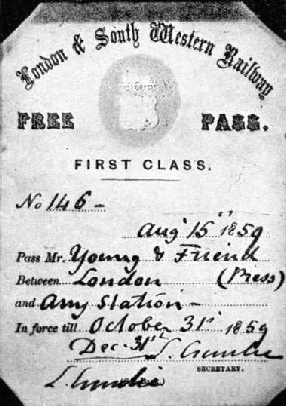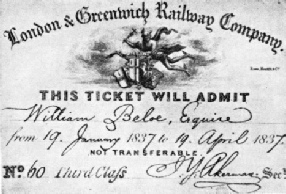

Romance of the Railway Ticket
The Story Behind the Slip of Pasteboard
COMMONPLACE in its appearance, the railway ticket may represent anything from a journey to the next village to a trip half-
The origin of the railway ticket can be traced to the days when stage coaches formed the principal means of travel, and the steam engine was an unknown thing.
In those days of uncertain departures and strictly limited accommodation it was essential for the intending traveller to secure his place in the stage coach at least twenty-
It was usual for the stage coach proprietors to engage one of the inn staff to serve as their representative and booking-
The clerk was required to enter in his book such details as the passenger’s name, the coach in which accommodation was desired, and whether he preferred to travel inside or outside the coach. The entries were made in triplicate. One copy of the paper ticket was handed to the passenger, another was retained in the issuing office, and a third was for the guard of the coach. It was not usual for the traveller to be called upon to pay his fare when booking; this was paid to the guard at the end of the journey.
For the most part the pioneer railways followed out this complicated system of booking inaugurated by the road carriers, the railway booking-
In place of the old paper slips, the Leicester and Swannington Railway introduced, in 1832, brass octagonal checks engraved with the name of the company, destination station and a serial number. These checks were employed for third-
For third-

A MEMENTO of other days. This free pass was issued to a journalist by the old London and South Western Railway, one of the lines that preceded the Southern Railway. This ticket was available from August 15, 1859 to October 31, 1859, but the period was extended till the end of the year.
Indestructible tickets did not enjoy a very long reign, although we have to-
Just as in the story of the steam locomotive one name stands out supreme -
Born in 1792, Thomas Edmondson served for a time as a cabinetmaker and a grocer. Then, in 1836, his opportunity came, and he was appointed station-
This called for the employment of a small wooden block, wherein there was set up in type the name and class of the most frequently issued tickets. With the aid of this block and a small mallet Edmondson printed rows of tickets upon suitable cardboard strip. To complete this, he numbered each ticket in serial order, cut it out of the cardboard strip, and stored it in a specially constructed case ready for issue. Next, Edmondson produced a ticket tube with a loose button, in which he stacked his tickets in numerical order, with the lowest number at the top. The bottom plate of the tube was counterbalanced by an arrangement of weighted strings and pulleys, and on removal of the uppermost ticket, the other tickets in the tube ascended to correspond. The invention of a ticket-
In the Lancaster Museum there is a well-

AMONG LONDON’S FIRST SEASON TICKETS were those issued by the London and Greenwich Railway Company. This cardboard ticket measured 3½ in by 2½ in, and was engraved with a figure of Mercury and the Company's arms and motto.
Thomas Edmondson died on June 22, 1851, but prior to his death the inventor had transferred his services from the Newcastle and Carlisle (now L&NE) line to the Manchester and Leeds Railway. On this system he introduced his special ticket arrangements, and by degrees Edmondson’s ticket machines found their way into every booking-
When Edmondson substituted metal machines for wooden ones, he took his brother Joseph and Blaycock into partnership. To-
The ordinary standard cardboard railway ticket measures 2¼ in long and 1-
The early tickets issued on the Manchester and Leeds Railway were especially interesting, because of the various distinguishing symbols printed on them for the guidance of the railway staffs and the public. Tickets for the woollen manufacturing town of Leeds bore the imprint of a fleece, and those for Manchester a cotton bag. Equally interesting was the representation of a thistle printed on the back of all tickets issued by the Scottish lines.

A METAL TICKET issued in 1843 by the Newcastle, North Shields and Tynemouth Railway. On one side are the Company’s arms, while on the other is denoted the class of travel to which the ticket was applicable.
Season tickets were a very early development on the English railways, although on some lines they were for long known as “periodical tickets”. An insight into early railway salesmanship is given by the the middle of last century, some of the north-
The platform ticket system is an idea that originated on the Continent. At the outset no charge was made for platform tickets by the English railways, but to-
Slot ticket issuing machines, for use where small fares are payable, are a recent successful development; while the interesting device known as the “passimeter” is also extensively employed at many busy ticket-
While many countries have adopted Edmondson’s cardboard ticket dimensions as standard, there are found quite a number of other shapes and sizes of tickets throughout the railway world. Some of the European lines favour tickets measuring 1½ in by ⅝ in. In Lithuania railway tickets are nearly 5 in. in length, while in Malta tickets measuring 1 sq in are common. Circular tickets are something of a rarity, but they are at present in use in British North Borneo. In Japan return tickets are often made just double the size of singles.

PAPER COUPON TICKETS from Liverpool to Warrington, issued in 1832, are shown in the upper picture. On the back of each ticket is: “Notice -
One of the largest series of railway tickets in the world is found in Persia, where the six-
In recent years, efforts have been made in England and elsewhere to reduce the number of special types of passenger ticket. Even to-
The practice of some railways of appointing outside agents for the sale of tickets has resulted in many special imprints. Thus, tickets issued by outside agents often bear the name or the initials of the sellers. Sometimes special colours are brought into use to indicate the particular agent from whom the tickets were purchased. In Holland, the inn-

AN INTERESTING COLLECTION OF OBSOLETE TICKETS. The first of these was the earliest dog-
Bilingual and polylingual passenger tickets are common in many countries. Palestine has railway, tickets printed in English, Turkish and Hebrew. Indian tickets are printed in several languages and dialects. In Belgium it is the custom to print tickets in both French and Flemish; while a number of Swiss passenger tickets carry wording in French, German and Italian.
There are remarkable stories behind the millions of railway tickets that eventually find their way back to the paper-
You can read more on
“Ticket and Change Machines” and
on this website.